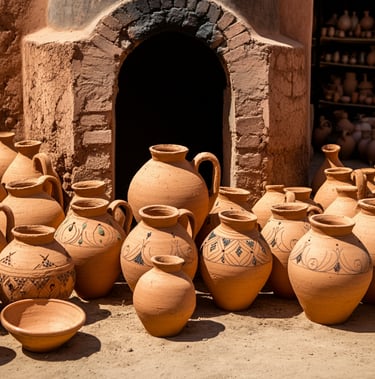Moroccan Clayware: Heritage, Sustainability, and Impact


Morocco's pottery embodies centuries of elaborate motifs, vivid hues, and distinctive shapes of Moroccan ceramics exemplify the expertise and ingenuity of the artists who create them. This esteemed skill serves as an artistic expression and a vital addition to Morocco's natural landscape. Historically dependent on natural materials and handmade methods, the pottery industry is increasingly adapting to increasing concerns over environmental sustainability. As global awareness changes towards sustainable methods, Moroccan pottery is evolving, harmonizing traditional preservation with ecological responsibility.
Environmental Consequences of Pottery Manufacturing
Pottery manufacturing, like several traditional crafts, can be resource-intensive, requiring significant use of raw materials and energy. Morocco sources clay, the primary substance for pottery, from the ground. Although clay is plentiful, unregulated and excessive exploitation may result in significant environmental repercussions, including soil erosion, biodiversity loss, and habitat damage. The disturbance of ecosystems, especially in regions with extensive pottery manufacturing, underscores the need for sustainable clay procurement.
The fire process, which frequently uses kilns powered by wood, charcoal, or fossil fuels, further intensifies the environmental impact of pottery manufacturing. The combustion of these fuels releases large quantities of carbon dioxide and other greenhouse gases into the atmosphere, exacerbating air pollution and climate change. In Morocco's rural regions, where handcrafted pottery is an important economic endeavor, the need for wood for kiln burning contributes to deforestation, exacerbating environmental issues.
Additionally, traditional Moroccan pottery often utilizes chemical glazes, many of which contain lead or other hazardous compounds. Improper handling or disposal of these compounds may result in leaching into soil and water systems, endangering environmental integrity and human health. Extended exposure to hazardous glazes may cause significant health complications for artisans, and inadequate coating or burning of pottery could pose risks for customers. This highlights the pressing need for the pottery sector to evaluate its environmental consequences and investigate more sustainable options.
Adopting Natural Materials and Methods
A significant characteristic of Moroccan ceramics is its enduring dependence on natural materials, especially clay and mineral-derived hues. Moroccan craftsmen have always used their surrounding environment, procuring local clay and using natural colors for ornamental applications. This localized strategy lowers the transportation-related carbon footprint and boosts the local economy by creating job opportunities within the neighborhood.
Recently, there has been a revival of interest in these conventional, environmentally sustainable methods. A multitude of craftspeople are reverting to natural, mineral-based glazes and organic colors to diminish their dependence on synthetic, chemical-laden substances. By using natural colors sourced from plants, minerals, and insects, potters are producing items that are both visually appealing and environmentally friendly for customers. The emphasis on natural materials corresponds with worldwide environmental trends and fosters a more responsible manufacturing methodology.
The use of natural elements in Moroccan pottery reflects a wider cultural principle: reverence for nature. For ages, Moroccan potters have seen their work as a means of connecting with the land, using its materials in a manner that demonstrates profound respect for the natural environment. By revisiting these origins, contemporary artists are both safeguarding cultural heritage and advancing a worldwide initiative for sustainable living.
Innovative strategies for sustainable pottery
In response to heightened environmental concerns in the global debate, the Moroccan ceramic sector has begun its evolution, emphasizing sustainability. Novel methodologies are emerging that seek to mitigate the ecological footprint of ceramic manufacturing while maintaining the integrity of traditional artistry. A coalition of individual craftspeople, municipal authorities, non-governmental organizations (NGOs), and global environmental campaigners propel these initiatives.
The development of more energy-efficient kilns is a breakthrough in the industry. Conventional wood- and coal-fired kilns, however, entrenched in artisanal tradition, are infamous for their inefficiency and elevated emissions. In response, potters and environmental groups have partnered to implement kilns that use cleaner-burning fuels, such as natural gas or renewable biomass. These contemporary kilns substantially minimize carbon emissions while sustaining the elevated temperatures required for ceramic firing. Alongside fuel economy, several organizations have investigated solar-powered kilns, using Morocco's abundant native traditions passed down through generations, intricately linked to the nation's cultural history. Sunshine is a sustainable energy resource.
The advocacy for sustainable clay procurement is another significant advancement. Multiple projects are striving to guarantee that clay mining occurs with little environmental impact. This encompasses measures such as alternating clay extraction locations to facilitate natural regeneration, using alternative resources such as reclaimed clay, and instructing potters on sustainable resource management. By implementing these measures, Moroccan craftsmen may mitigate the long-term environmental consequences of their trade.
Moreover, environmentally sustainable glazes and paints are becoming more popular. Artisans are innovating with lead-free and non-toxic glazes that maintain the vivid colors and finishes characteristic of Moroccan ceramics. This transition enhances environmental sustainability, improves artists' working circumstances, and elevates customer safety regarding the end product. Workshops and training programs help to advance these safer materials by equipping craftspeople with the knowledge and skills needed to adopt more sustainable manufacturing techniques.
The Function of Education and Community Programs
Education and community involvement are essential for the shift to sustainable pottery manufacturing in Morocco. Numerous organizations, both domestic and global, have acknowledged the need to provide craftsmen with the resources and expertise required to implement sustainable practices. These organizations provide seminars concentrating on sustainable clay procurement, non-toxic glazing methods, and energy-efficient kiln management.
Besides formal training programs, several groups collaborate directly with artisan communities to enhance their understanding of the environmental consequences of traditional ceramic processes. These programs seek to cultivate environmental stewardship, empowering craftspeople to assume responsibility for advancing sustainability. This grassroots methodology is essential for embedding sustainable practices within the Moroccan ceramics sector.
Joint initiatives among craftspeople, environmental organizations, and municipal authorities have resulted in the establishment of certification schemes for sustainable pottery. These certificates signify quality and environmental accountability, assisting customers in recognizing items manufactured using sustainable materials and practices. These programs are fostering demand for certified sustainable ceramics and motivating more craftsmen to embrace eco-friendly processes.
The global demand for eco-friendly ceramics
With customer tastes increasingly favoring sustainable and ethically produced products, Moroccan ceramics had the potential to excel in the global market. The demand for handcrafted, sustainable goods is rising, especially in Europe and North America, where consumers are more aware of the environmental and social consequences of their choices. Moroccan pottery, characterized by its profound cultural history and dedication to sustainability, is perfectly suited to fulfill this need.
This global market shift allows Moroccan craftsmen to broaden their reach and improve their businesses while remaining faithful to their traditional expertise. By utilizing sustainable processes and adhering to global eco-friendly standards, Moroccan pottery can contribute to environmental preservation and enhance its global appeal.
Summary
The Moroccan ceramics sector, firmly entrenched in cultural heritage, is experiencing a vital shift towards sustainability. In response to growing environmental concerns influencing consumer behavior and worldwide industry norms, Moroccan potters are using creative methods to mitigate their ecological footprint while preserving the authenticity of their art. The use of natural materials, energy-efficient technology, and environmentally friendly glazes demonstrates an increasing dedication to sustainable practices within the industry.
The progression of Moroccan pottery towards sustainability is not only a fad, but a critical measure for environmental preservation and the enduring legacy of this cherished art. By harmonizing tradition with innovation, Moroccan artists are preserving their cultural legacy while simultaneously fostering a more sustainable future. The global transition towards sustainable manufacturing highlights Moroccan ceramics as a significant illustration of the synergy between cultural preservation and environmental stewardship.
